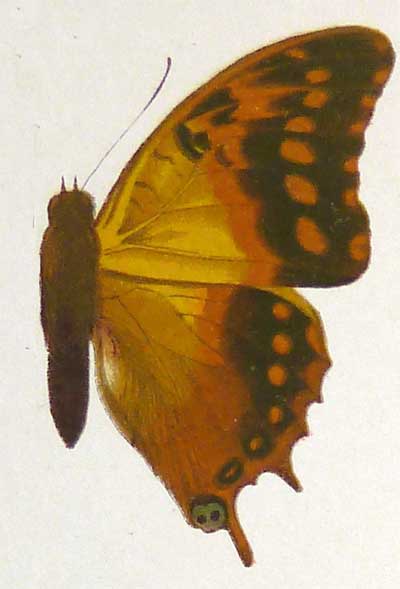
Superregnum: Eukaryota
Cladus: Unikonta
Cladus: Opisthokonta
Cladus: Holozoa
Regnum: Animalia
Subregnum: Eumetazoa
Cladus: Bilateria
Cladus: Nephrozoa
Cladus: Protostomia
Cladus: Ecdysozoa
Cladus: Panarthropoda
Phylum: Arthropoda
Subphylum: Hexapoda
Classis: Insecta
Cladus: Dicondylia
Subclassis: Pterygota
Cladus: Metapterygota
Infraclassis: Neoptera
Cladus: Eumetabola
Cladus: Endopterygota
Superordo: Panorpida
Cladus: Amphiesmenoptera
Ordo: Lepidoptera
Subordo: Glossata
Cladus: Coelolepida
Cladus: Myoglossata
Cladus: Neolepidoptera
Infraordo: Heteroneura
Cladus: Eulepidoptera
Cladus: Ditrysia
Cladus: Apoditrysia
Cladus: Obtectomera
Superfamilia: Papilionoidea
Familia: Nymphalidae
Subfamilia: Charaxinae
Tribus: Charaxini
Genus: Charaxes
Species: Charaxes candiope
Name
Charaxes candiope (Godart, 1824)
Synonymy
Nymphalis candiope Godart, 1824
Charaxes candiope (Godart):
Charaxes viridicostatus Aurivillius, 1879 (synonymized by Rothschild & Jordan, 1900: 366)
Type locality: Namibia, Damaralandet.
References
Additional references
Williams, M.C. 2007. Checklist of Afrotropical Papilionoidea and Hesperioidea. 7th Edn. (April 2007). Downloaded from Afrotropical Butterflies. Reference page.
Charaxes candiope, the green-veined emperor or green-veined charaxes, is a butterfly of the family Nymphalidae.It is common in sub-Saharan Africa.
Habitat in Tanzania
Biology
The habitat is forest and savanna excluding arid savanna.It also occurs in gardens and agricultural areas. Notes on the biology of candiope are given by Pringle et al (1994), Larsen, T.B. (1991), Larsen, T.B. (2005) and Kielland, J. (1990). [3] [4][5][6] Flight period is from October to June.[7]
Description
Green-veined emperor
The wingspan is 45–55 mm in males and 50–60 mm in females. The basic colour of the upperside wings is tawny or orange tawny, with a basal area slightly paler or pale ochre yellow. The unscaled veins and the costal edge of forewing are green. The hindwings have a submarginal black band with a series of tawny ochreous or whitish interstitial spots. The undersides of the forewings are clayish, slightly ochreous, while the hindwings are sepia colour. Forewings are rather falcate, while the hindwings have two small tails protruding from the lower edge.
Full description
A full description is given by Walter Rothschild and Karl Jordan, 1900 Novitates Zoologicae volume 7:287-524. [1] page 364 et seq. (for terms see Novitates Zoologicae volume 5:545-601 [2])
Life history
Larvae have large green bodies and heads decorated with horns. They feed on Croton sylvaticus, Croton gratissimus, and Croton megalocarpus.[7][8]
Distribution
This species can be found in most of the Afrotropical realm (Sub-Saharan Africa).[8]
Taxonomy
Charaxes candiope group. The group members are:[9]
Charaxes candiope
Charaxes antamboulou like next
Charaxes cowani like last
Charaxes velox
Charaxes thomasius
References
Coetzer, B.H.; Westrip, J.R.S. (2020). "Charaxes candiope". IUCN Red List of Threatened Species. 2020: e.T160057A161316474. doi:10.2305/IUCN.UK.2020-3.RLTS.T160057A161316474.en. Retrieved 20 November 2021.
Godart, J.-B. 1832-1835. Supplement a l’Histoire Naturelle des Lepidopteres ou Papillons de France 1 Diurnes 1-440. Paris.
Pringle et al , 1994. Pennington’s Butterflies of Southern Africa, 2nd edition
Larsen, T.B. 1991The Butterflies of Kenya and their Natural History. Oxford University Press, Oxford: i-xxii, 1-490.
Kielland, J. 1990. Butterflies of Tanzania. Hill House, Melbourne and London: 1-363.
Larsen, T.B. 2005 Butterflies of West Africa. Apollo Books, Svendborg, Denmark: 1-595 (text) & 1-270 (plates).
Woodhall, Steve (2005). Field Guide to Butterflies of South Africa. Cape Town, South Africa: Struik. ISBN 978-1-86872-724-7.
"Charaxes Ochsenheimer, 1816" at Markku Savela's Lepidoptera and Some Other Life Forms
Bernard Turlin, 2007 Schmetterlinge der Erde, Butterflies of the world Part 25 Nymphalidae XII, Charaxes II. Edited by Erich Bauer and Thomas Frankenbach Keltern: Goecke & Evers; Canterbury: Hillside Books.ISBN 9781903237359
Victor Gurney Logan Van Someren, 1974 Revisional notes on African Charaxes (Lepidoptera: Nymphalidae). Part IX. Bulletin of the British Museum of Natural History (Entomology) 29 (8):415-487. [3]
Seitz, A. Die Gross-Schmetterlinge der Erde 13: Die Afrikanischen Tagfalter. Plate XIII 32
Retrieved from "http://en.wikipedia.org/"
All text is available under the terms of the GNU Free Documentation License

